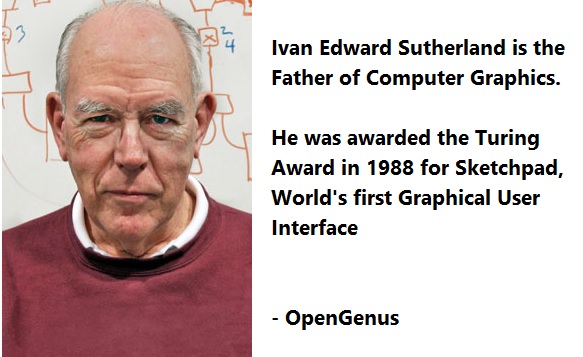
Open-Source Internship opportunity by OpenGenus for programmers. Apply now.
Reading time: 30 minutes
Ivan Edward Sutherland is a computer scientist, professor, entrepreneur and Turing Award Winner and is widely regarded as the Father of Computer Graphics. He has received numerous awards over the years and has over 60 patents. He has been associated with top universities like Harvard University, Massachusetts Institute of Technology and others and has been working at Sun Microsystems. He founded two companies namely Evans and Sutherland and Sutherland Sproull and Associates
He has driven the Computer Graphics field to mainstream development and has laid the foundations of Virtual Reality as well which is one of the promising growing fields.

He was born on May 16, 1938 in Hastings, Nebraska, United States
Over the years, he has worked on a variety of fields including:
- Integrated circuits
- Computer Graphics
- Virtual Reality
Computer Graphics refer to the field of rendering visual images and videos on computers and how computers deal with visual information. Even, we have developed specific acceleration hardware for computer graphics known as Graphics Processing Unit (GPU).
Following image illustrates the evolution of Computer Graphics over the years:

Education background
Ivan Edward Sutherland's education background is as follows:
- Bachelor's degree in Electrical engineering from Carnegie Mellon University in 1959
- Master's degree from California Institute of Technology in 1960
- Ph.D. from Massachusetts Institute of Technology in Electrical engineering and Computer Science in 1963
At MIT, his supervisor was Claude Shannon, the inventor of information theory. They decided to work on SAGE air defence project which needed computers that were fast and had graphical inputs and output. The light pen was invented for the SAGE project but the output displays were crude adaptations of radar displays.
They built the TX2 which used transistors and an array of real time input and output devices in 1959 and was a 38-bit word machine with a 68Kword main memory.

University and Industrial association
- Sutherland replaced J. C. R. Licklider as the head of the US Defense Department Advanced Research Project Agency's Information Processing Techniques Office (IPTO) in 1964
- From 1965 to 1968, Sutherland was an Associate Professor of Electrical Engineering at Harvard University.
- From 1968 to 1974, Sutherland was a professor at the University of Utah.
- From 1974 to 1978 he was the Fletcher Jones Professor of Computer Science at California Institute of Technology
- Sutherland was a Fellow and Vice President at Sun Microsystems
- Sutherland was a visiting scholar in the Computer Science Division at University of California, Berkeley (Fall 2005–Spring 2008)
Entrepreneurial quest
- In 1968 he co-founded a company named Evans and Sutherland with his friend and colleague David C. Evans. The company did pioneering work in the field of real-time hardware, accelerated 3D computer graphics and printer languages.
It is the world leader in providing flying simulators for pilot training shipping equipment worth $150 million.
- He founded a consulting firm named Sutherland Sproull and Associates which was purchased by Sun Microsystems to form the seed of its research division, Sun Labs.
Work
- In 1959, he developed TX2, a 38-bit word machine with a 68Kword main memory along with Claude Shannon at MIT for SAGE air defence project
The TX-1 and TX-2 were the starting points for DEC’s PDP1 and PDP 6 machines
-
In 1962, he developed Sketchpad, World's first Graphical User Interface. It had features to draw both horizontal and vertical lines and combine them into figures and shapes. Figures could be copied, moved, rotated, or resized, retaining their basic properties.
-
In 1967, he developed the Cohen Sutherland line clipping algorithm which is one of the foundations of learning Computer Graphics today
-
In 1966, he took the first step towards Virtual Reality. He replaced the TV camera that fed the primitive “head-mounted display” with a computer connection. worn by the user was so heavy it had to be suspended from the ceiling, and the graphics comprising the virtual environment were simple wireframe model rooms.
-
In 1972, he developed the system for Display Windowing by Clipping
-
In 1972, he developed Vector Computing System as for use in a Matrix Computer
-
In 1974, he developed a Computer Graphics Clipping System for Polygons
-
In 2008, he developed a method and apparatur for high-throughput asynchronous communication and electronically aligning capacitively coupled mini-bars
Notable Awards
- National Academy of Engineering First Zworykin Award in 1972
- National Academy of Engineering member in 1973
- Member, United States National Academy of Sciences in 1978
- IEEE Emanuel R. Piore Award in 1986
- Computerworld Honors Program, Leadership Award in 1987
- Turing Award in 1988
- ACM Software System Award in 1993
- Electronic Frontier Foundation EFF Pioneer Award in 1994
- Association for Computing Machinery Fellow in 1994
- CyberEdge Journal Virtual Reality Pioneer Award in 1996
- The Franklin Institute's Certificate of Merit in 1996
- IEEE John von Neumann Medal in 1998
- R&D 100 Award in 2004
- Computer History Museum Fellow for the Sketchpad in 2005
- Kyoto Prize in 2012
- National Inventors Hall of Fame Inductee in 2016
- BBVA Fronteras del conocimiento in 2019
“Young people are wonderful. They don’t know what they can’t do, so they go ahead and do it.” - Ivan Edward Sutherland
